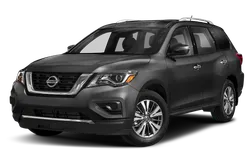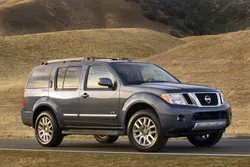

Nissan Pathfinder Generation 3 Facelift 2010 Overview
Explore the Nissan Pathfinder, focusing on the Pathfinder Generation 3 Facelift 2010. Discover its features, specifications, and reasons to consider this model in Portugal.
The Nissan Pathfinder has undergone several transformations since its inception, and the third generation (2005-2012) marked a pivotal point in its evolution. The facelift in 2010 breathed new life...
Technical Specifications
Select Version
Dimensions
Engine
Driving
Others
History and Features
Mycarro AI
Apr 27, 2025
The Nissan Pathfinder has undergone several transformations since its inception, and the third generation (2005-2012) marked a pivotal point in its evolution. The facelift in 2010 breathed new life into the model, offering significant updates that enhanced its appeal in a competitive SUV market. This article dives into the features, design changes, performance upgrades, and overall reception of the third-generation Nissan Pathfinder facelift.
Design Changes
The 2010 facelift of the Nissan Pathfinder introduced a more modern and aggressive exterior design. While the fundamental silhouette remained consistent with its predecessors, notable changes included a redesigned grille, new headlights, and updated taillights that together provided a fresh and contemporary look. The front bumper was also revised, integrating larger air intakes which not only improved aesthetics but also contributed to enhanced engine cooling. These revisions allowed the Pathfinder to better align with Nissan's broader styling direction, appealing to families looking for both functionality and style.
Interior Comfort and Technology
Inside, the 2010 Pathfinder maintained its commitment to spaciousness while making strides in comfort and technology. The cabin boasted higher-quality materials, updated upholstery, and an overall refined atmosphere. One of the most significant changes was the addition of upgraded audio systems, including an optional Rockford Fosgate premium sound system that enhanced the driving experience. The incorporation of Bluetooth connectivity and an advanced navigation system made it easier for drivers to stay connected and navigate effortlessly.
In terms of seating arrangement, the Pathfinder offered a flexible three-row seating configuration suitable for up to seven passengers. The third row was easier to access than before, and the rear seats could fold flat to provide ample cargo space for families on the go. This combination of comfort and practicality made the Pathfinder an excellent choice for those seeking a reliable family SUV.
Performance and Powertrain
Under the hood, the 2010 facelift retained the robust performance characteristics the Pathfinder was known for. It featured a 4.0-liter V6 engine that delivered 266 horsepower, paired with a five-speed automatic transmission. This powertrain combination provided smooth acceleration and competent towing capacity, making it ideal for navigating both city roads and rugged terrains.
The Pathfinder was available in either rear-wheel drive (RWD) or four-wheel drive (4WD) configurations, allowing buyers to select the option that best suited their driving needs. The 4WD system came with a selectable mode for off-road enthusiasts, enabling the Pathfinder to tackle various challenges, whether it be mud, snow, or rocky landscapes. This adaptability reinforced its reputation as a rugged yet family-friendly SUV.
Safety Enhancements
Safety was a priority for the 2010 Pathfinder, and it was equipped with various features designed to enhance occupant protection. Standard safety equipment included anti-lock brakes, stability control, and a suite of airbags. For higher trim levels, additional features like rear parking sensors, a rearview camera, and a tire pressure monitoring system were made available. These enhancements contributed to an overall sense of security for families and bolstered the Pathfinder’s standing in safety ratings.
Market Reception
Upon its release, the 2010 Pathfinder facelift received generally positive reviews from both critics and consumers. Many praised the blend of rugged performance with family-friendly features, making it a versatile choice for active lifestyles. The changes introduced in the facelift were seen as a successful modernization that helped the Pathfinder maintain its relevance in a rapidly evolving SUV market.
Conclusion
The third generation Nissan Pathfinder, especially the 2010 facelift, represented a significant point in the model's ongoing legacy. By combining enhanced aesthetics, modern amenities, commendable performance, and a focus on safety, Nissan successfully rejuvenated a beloved SUV that appealed to a wide range of drivers. As families sought both a reliable everyday vehicle and an adventurous travel companion, the Pathfinder emerged as a solid choice—proving that Nissan could blend capability with style effectively.
